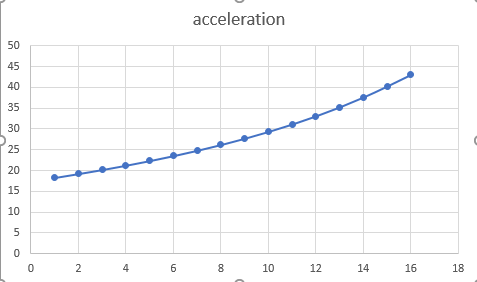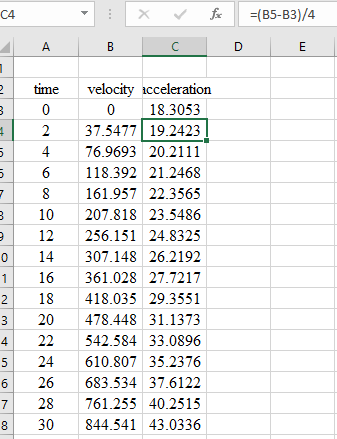
The upward velocity of a rocket can be computed by the following formula:
Where
To calculate: The height of the rocket at
Answer to Problem 46P
Solution:
All the results are summarized in the table below,
Acceleration graph is shown below.

Explanation of Solution
Given Information:
The formula for the upward velocity of rocket is given as,
Here,
Formula Used:
6-segment Trapezoidal rule.
6-segmentSimpson’s 1/3 rule.
Change of variable formula.
Here,
Error Calculation.
Calculation:
Calculate the upward velocity of the rocket.
Substitute thegiven values in equation(1),
Apply 6-segment Trapezoidal rule for
Here,
Substitute
Expand the above terms.
Calculate
Substitute
Calculate
Substitute
Calculate
Substitute
Similarly, calculate all the function values.
Substitute above values in equation(3),
The formula for 6-segment Simpson’s 1/3 rule,
Substitute the function values from above,
The given velocity Integral is,
Change of variable before integrating the function,
And
Here,
Substitute the values of
Substitute the values of
Thus, the transformed function is,
Apply Six-Point Gauss Quadrature formula.
Calculate
Substitute
Calculate
Substitute
Similarly, calculate all function values.
Substitute the values in Six-Point Gauss Quadrature formula.
Apply Romberg Integration.
Choose
Substitute value from above and calculate
Choose
Substitute values from above and calculate
Choose
Substitute values from above and calculate
Choose
Substitute values from above and calculate
Substitute values from above and calculate
Calculate the approximate error,
Substitute values from above.
Substitute values from above and calculate
Substitute values from above and calculate
Substitute values from above and calculate
Calculate the approximate error,
Substitute values from above,
Substitute values from above and calculate
Substitute values from above and calculate
Calculate the approximate error as,
Substitute values from above.
All above calculated results are summarized in the table below,
UseNumerical differentiation to calculate acceleration as a function of time.
Apply finite-divided differences for
Apply centred differences to calculate the intermediate values,
Similarly, calculate all intermediate values of acceleration.
Apply backward difference for the last value at t = 30 s,
All of the results are displayed in the following table and graph,

Select the time and acceleration column and go to insert chart and scattered chart. The graph of acceleration verses time is plotted as follows:

Want to see more full solutions like this?
Chapter 24 Solutions
Numerical Methods for Engineers
- Solve the following exercises based on Principles 11-14, although an exercise may require the application of two or more of any of the principles. Round the answers to 3 decimal places where necessary unless otherwise stated. a. If radius x = 7.500" and y = 4.500", find PM. b. If radius x = 8.000" and y = 4.800", find PM.arrow_forwardSolve the following exercises based on Principles 15-17, although an exercise may require the application of two or more of any of the principles. Round the answers to 3 decimal places where necessary unless otherwise stated. Point A is a tangent point of the V-groove cut and pin shown. All dimensions are in inches. a. If y = 1.400", find x. b. If y = 1.800", find x.arrow_forward
- Algebra & Trigonometry with Analytic GeometryAlgebraISBN:9781133382119Author:SwokowskiPublisher:Cengage
 Algebra: Structure And Method, Book 1AlgebraISBN:9780395977224Author:Richard G. Brown, Mary P. Dolciani, Robert H. Sorgenfrey, William L. ColePublisher:McDougal Littell
Algebra: Structure And Method, Book 1AlgebraISBN:9780395977224Author:Richard G. Brown, Mary P. Dolciani, Robert H. Sorgenfrey, William L. ColePublisher:McDougal Littell Mathematics For Machine TechnologyAdvanced MathISBN:9781337798310Author:Peterson, John.Publisher:Cengage Learning,
Mathematics For Machine TechnologyAdvanced MathISBN:9781337798310Author:Peterson, John.Publisher:Cengage Learning, 



